Viewing archive of Sunday, 20 November 2011 - Sunspot regions

| Sunspot number | New regions | Background flux | Maximum flux | C |
|---|---|---|---|---|
| 101 -48 | 1 | B8.57 | C8.73 | 11 |
Sunspot regions
Region 11343 |
||||
|---|---|---|---|---|
| Number of sunspots |
Size | Class Magn. | Class Spot | Location |
| 1 | 40 -10 | HSX | N27W87 | |
Region 11346 |
||||
|---|---|---|---|---|
| Number of sunspots |
Size | Class Magn. | Class Spot | Location |
| 6 -1 | 60 -20 | HSX | S18W29 | |
Region 11347 |
||||
|---|---|---|---|---|
| Number of sunspots |
Size | Class Magn. | Class Spot | Location |
| 3 2 | 10 | AXX | N06W37 | |
Region 11349 |
||||
|---|---|---|---|---|
| Number of sunspots |
Size | Class Magn. | Class Spot | Location |
| 2 | 10 | BXO | N15W67 | |
Region 11350 |
||||
|---|---|---|---|---|
| Number of sunspots |
Size | Class Magn. | Class Spot | Location |
| 4 -3 | 40 -30 | CSO | N25E03 | |
Region 11351 |
||||
|---|---|---|---|---|
| Number of sunspots |
Size | Class Magn. | Class Spot | Location |
| 2 -2 | 10 | HRX | S24W17 | |
Region 11352 |
||||
|---|---|---|---|---|
| Number of sunspots |
Size | Class Magn. | Class Spot | Location |
| 6 2 | 110 -60 | CSO | S24E26 | |
Region 11353 |
||||
|---|---|---|---|---|
| Number of sunspots |
Size | Class Magn. | Class Spot | Location |
| 1 | 40 10 | HSX | N07E44 | |
Region 11354 |
||||
|---|---|---|---|---|
| Number of sunspots |
Size | Class Magn. | Class Spot | Location |
| 12 4 | 220 10 | DSI | S17E44 | |
Solar flares on this day | ||||
| C3.06 C6.96 C4.38 C1.52 C8.76 C3.05 | ||||
Region 11355 |
||||
|---|---|---|---|---|
| Number of sunspots |
Size | Class Magn. | Class Spot | Location |
| 1 -2 | 90 30 | HSX | N14E58 | |
Region 11356 |
||||
|---|---|---|---|---|
| Number of sunspots |
Size | Class Magn. | Class Spot | Location |
| 1 | 60 | HSX | N14E81 | |
Solar flares on this day | ||||
| C2.61 | ||||
All times in UTC
Current data suggests there is a moderate possibility for aurora to appear at the following high latitude regions in the near future
Gillam, MB, Whitehorse, YT, Yellowknife, NTFairbanks, AK
Current data suggests there is a slight possibility for aurora to appear at the following high latitude regions in the near future
Edmonton, AB, Iqaluit, NU, Saskatoon, SKAnchorage, AK, Juneau, AK
Current data suggests there is a slight possibility for aurora to appear at the following middle latitude regions in the near future
Calgary, ABLatest news
Latest forum messages
Support SpaceWeatherLive.com!
A lot of people come to SpaceWeatherLive to follow the Sun's activity or if there is aurora to be seen, but with more traffic comes higher server costs. Consider a donation if you enjoy SpaceWeatherLive so we can keep the website online!

Latest alerts
04:03 UTC - Hemispheric Power Index
The OVATION model predicts the Hemispheric Power Index to reach 50GW at 04:56 UTC
01:45 UTC - Geomagnetic activity
Active geomagnetic conditions (Kp4) Threshold Reached: 01:32 UTC
Tuesday, 1 April 2025
22:51 UTC - Solar flare
Moderate M2.5 flare
22:30 UTC - Radio Blackout
Minor R1 radio blackout in progress (≥M1 - current: M1.45)
07:15 UTC - 10cm Radio Burst
Begin Time: 01/04/2025 06:45 UTC Maximum Time: 01/04/2025 06:45 UTC Duration: 1 minutes. Peak flux: 190 sfu
Space weather facts
| Last X-flare | 2025/03/28 | X1.1 |
| Last M-flare | 2025/04/01 | M2.4 |
| Last geomagnetic storm | 2025/03/27 | Kp5 (G1) |
| Spotless days | |
|---|---|
| Last spotless day | 2022/06/08 |
| Monthly mean Sunspot Number | |
|---|---|
| February 2025 | 154.6 +17.6 |
| April 2025 | 147 -7.6 |
| Last 30 days | 128.8 -21.8 |




